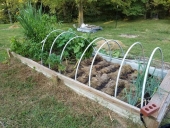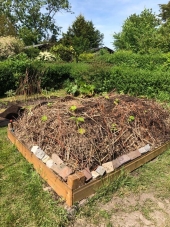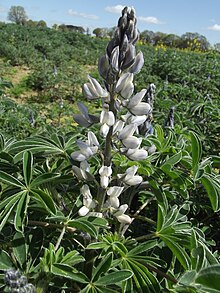Hi Nancy,
It's interesting to hear the hugel bed being used as a remedy for damp soil - usually it's used for drier conditions
I have drought AND flooding problems... I live in the Netherlands close to the coast right next to a (small) dyke. Our summers are getting warmer and
drier every year. Alternating with extremely wet summers every few years. Our winters are getting warmer and
wetter. Sometimes we experience short lived freakishy cold spells. Often at the end of winter when spring is supposed to make an appearance. These kill of animals and plants that are either used to warmer climes (having migrated due to the warmer temps) or didn't go into proper hibernation/ forgot to shed their leaves/ are already budding. If a plant in standing in heavy waterlogged soil it's doomed.
The groundwater level is always pretty high (mostly one to two spades deep) so when we have a really wet warm winter the soil turns to sloppy mud. This makes it near impossible to walk in the vegetable garden in winter. The soil consists of really heavy river/sea clay with little plant matter so it goes rock solid during a hot summer. Look at the picture taken in May. You can see the cracked soil right next to the hugel. It gets worse as summer progresses. I'd like to grow veg without bringing in lots of extra water and pumpkins are big slurpers.
In winter plants drown or their roots rot and in summer plants struggle to get moisture unless they have a deep established root system. Which most don't have because of the high ground water level and heavy heavy near impenetrable clay. For the past few years the ground water level has been lowered slightly in summer by the Water Authority (I don't have a better translation) in order to have enough water in the rivers to keep the salty seawater from flowing upstream. Trees have suffered.
I've been composting like crazy and adding as much plant matter to my soil as I can manage. And it helps, a lot, but not enough in the wettest parts of the garden.
So, hugel. Garden friends have already asked me to teach a hugel build class lol.
I've harvested my beautiful pumpkins and did some small maintenance. There is some rodent activity but not as bad as I had feared. Mostly some mice. And lots of toads, frogs and slamanders getting ready for winter. I've (carefully) started planting perennial food plants. I'll try to take some pics this weekend.








 I grew lots of pumpkins without having to water during the dry hot months. So this year I'm building another one! If interested you can read my post: https://permies.com/t/190521/Hugel-anti-drought-flood-success.
I grew lots of pumpkins without having to water during the dry hot months. So this year I'm building another one! If interested you can read my post: https://permies.com/t/190521/Hugel-anti-drought-flood-success.





